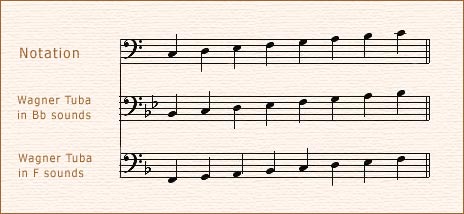This is an area of some confusion, principally caused by Wagner himself who varied his notation even within the one work of The Ring. For example, in Walkure and Siegfried the tuba parts are given in Eb and Bb, the tenor tubas in the treble clef sounding a 6th lower than written, the bass tubas in the bass clef a tone lower. However, in Rheingold and also in the Vorspiel of Götterdämmerung they are in Bb/F notation. Switching back again, from Act 1 of Götterdämmerung through to the end of the work Wagner reverted to the double transposition of Eb and Bb.
The following however would seem to be the accepted norm with the Tenor Bb Wagner Tuba sounding a major second lower than written and the Bass Wagner Tuba in F sounding a fifth lower than written.

Composers of works involving the Wagner Tuba since Richard Wagner’s time have all experienced a dilemma with the instrument’s notation.
For today’s orchestral performances, most Wagner Tuba parts have been totally transcribed and retain the standard F Horn transposition throughout. In this way, the uncertainty is avoided by horn players.